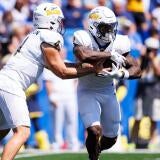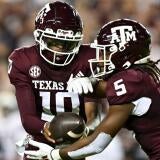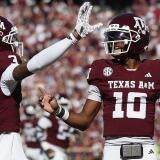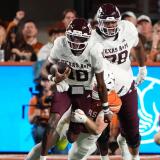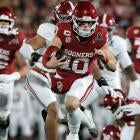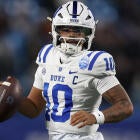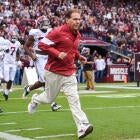Oklahoma, Texas deliver another classic Red River Rivalry as SEC salivates over what's to come in 2024
The Big 12 sendoff edition of the Red River Rivalry reminded why the SEC coveted these teams so much
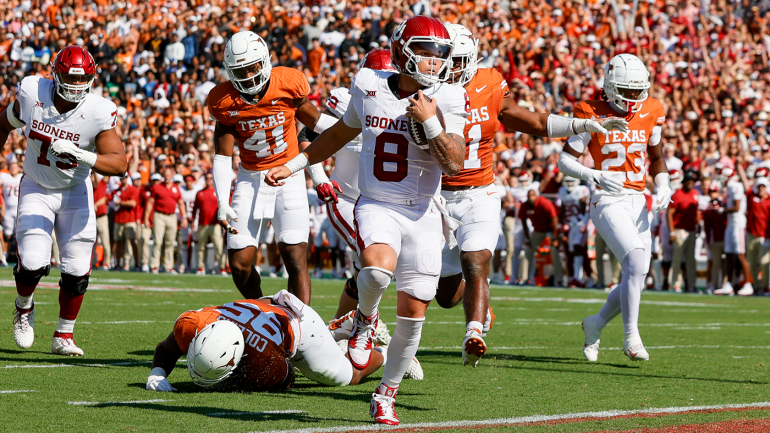
Name whatever subversive you wish when describing latest round of conference realignment. When word leaked two years ago that Texas and Oklahoma were headed to the SEC, there was plenty of blame to go around.
Greg Sankey? ESPN? The collapse of crypto? Social media?
More than scapegoats, it was flat out shock from the 35,000-foot level. The fabric of the game was being ripped apart. Don't forget, by losing its two giants at that point in July 2021, the Big 12 was leaking more oil than a '58 Buick. The thought of an actual FBS conference collapsing was incomprehensible. (Since proven comprehensible by the Pac-12.)
Former Big 12 commissioner Bob Bowlsby acted quickly to backfill, and when the angst cleared, the reason for the migration of the two titans to the nation's best conference became obvious.
It wasn't so much about TV markets or geography or even athletic budgets ... it was about brands and rivalries. You know, the stuff that breaks up tight-knit families and sets record TV ratings.
Alabama-Auburn, Michigan-Ohio State, Florida-Georgia, Texas-Oklahoma: We always watch.
Whoever owns the most of those properties is going to make a whole lot of money. You want to know why Texas and Oklahoma are joining the SEC next season? You got your answer on a beautiful Saturday in Dallas at the Cotton Bowl.
No. 3 Texas rallied from a 10-point deficit in the third quarter only to see its efforts melt away when No. 12 Oklahoma scored with 15 seconds left to win 34-30. That's what separated Texas coach Steve Sarkisian from validation of his three-year plan to fully resurrect the Longhorns. That's how close they were to really, truly being "back."
The Horns' quest isn't over yet. Neither is that of the Sooners, which are off to a 6-0 start. The best thing about Saturday's result in the Red River Rivalry is a possible rematch less than two months from now.
Playing their last year in the Big 12, it's possible Oklahoma and Texas could make the College Football Playoff if the Horns return the favor in the Big 12 Championship Game.
Either way, the SEC will be waiting with open arms. We (the consumers) will be right behind them.
Red River transcends conferences. For decades, it was Big Eight vs. Southwest. For more than a quarter century, Texas and Oklahoma were together in the Big 12. Now, they will test their mettle at the highest level in the SEC.
That doesn't justify realignment, but it explains it to almost anyone who matters: fans, players, advertisers, networks ... eyeballs.
Beginning next year, not only will Texas-Oklahoma be an SEC game, so will Texas-Florida, Texas-Alabama, Oklahoma-Georgia, Oklahoma-LSU and obviously Texas-Texas A&M.
The SEC has Texas-Oklahoma for good, supposedly. ESPN has Texas-Oklahoma to itself for the next decade starting in 2024, per the SEC's new media rights deal. The network previously shared that rivalry with Fox under the existing Big 12 contract.
Saturday showed us why all four parties did what was necessary for UT and OU to exit the Big 12 contract a league early.
Rivalries matter in college sports, perhaps more than anything else. Texas-Oklahoma might matter more than any rivalry. You'll get an argument from the Iron Bowl, The Game and the game formerly known as the World's Largest Outdoor Cocktail Party, but they'll have to beat what we saw Saturday.
Sankey, the SEC commissioner, can only be thrilled at what he saw in person and Big 12 counterpart Brett Yormark did not. (Yormark had already attended multiple UT and OU games this season.)
Nine of the last 11 and 27 of the last 50 Red River Rivalry meetings have been decided by one possession. A couple of months after 9/11, in 2001, snipers were posted atop nearby buildings to ensure there were no incidents.. The son of hall of fame ex-Oklahoma coach Bob Stoops, Drake, caught two key passes on Saturday's game-winning possession.
It was clear as the game went on that the 119th meeting was going to provide more lore. Oklahoma quarterback Dillon Gabriel was playing in first Red River in his fifth year of eligibility. If he doesn't go pro, he'll be playing in his third conference next season. A quarterback from Hawaii, who had played at UCF, resurrected Oklahoma and handed it off nicely to the SEC.
"This is why I came here," Gabriel said afterward. "Baker [Mayfield] called me last night. He said, 'Do whatever it takes.' I love OU football. This is what college football is all about."
Gabriel literally did whatever it took. Last year, he missed the game with concussion symptoms. On Saturday, he put his body on the line rushing for a career-high 113 yards.
Similarly validated was Oklahoma coach Brent Venables. The longtime defensive genius, in his second year as a head coach, showed he had grown into the job after a lackluster 6-7 debut in 2022 that brought questions about his fit. Venables' defense may have won the game making a goal line stand with 54 seconds left in the third quarter. Texas turned it over on downs trailing by a touchdown.
Texas QB Quinn Ewers was on the brink of defining himself. In rallying the Horns back from that 10-point deficit, he completed 19 consecutive passes and 25 of his last 27. But Ewers also turned it over three times in the game. The only redemption for the former five-star prospect will be winning out and getting revenge on Oklahoma in a rematch.
There is no one to blame except maybe the Texas defense, which had shut out Oklahoma for 24:45 of the last 25 minutes of the games -- all except the last 15 ticks. Gabriel ducked pressure and found redshirt freshman Nic Anderson in the back of the end zone. If the dagger can feel any more painful for UT, Anderson is from Katy, Texas.
How's that for aggregating an audience?
On their way out of the Big 12, both teams reminded the league they left behind what their future means to the SEC ... and all of college football.



